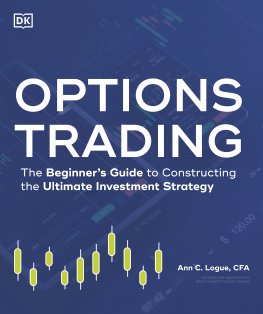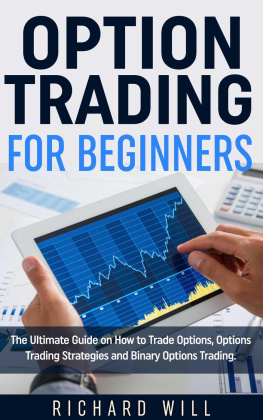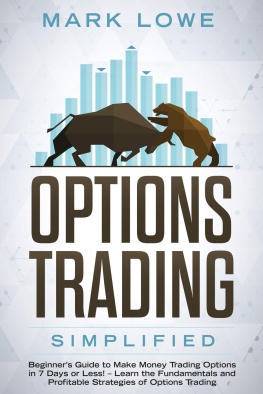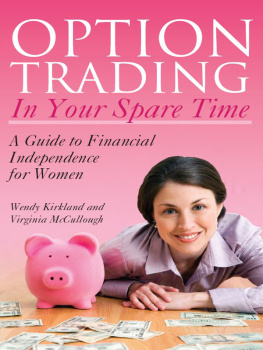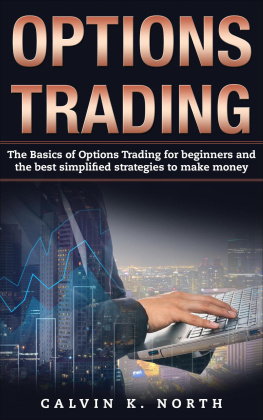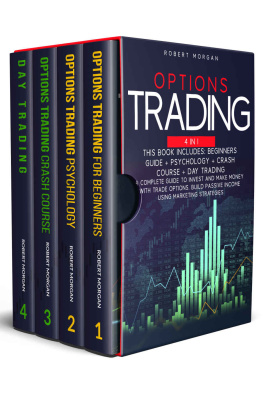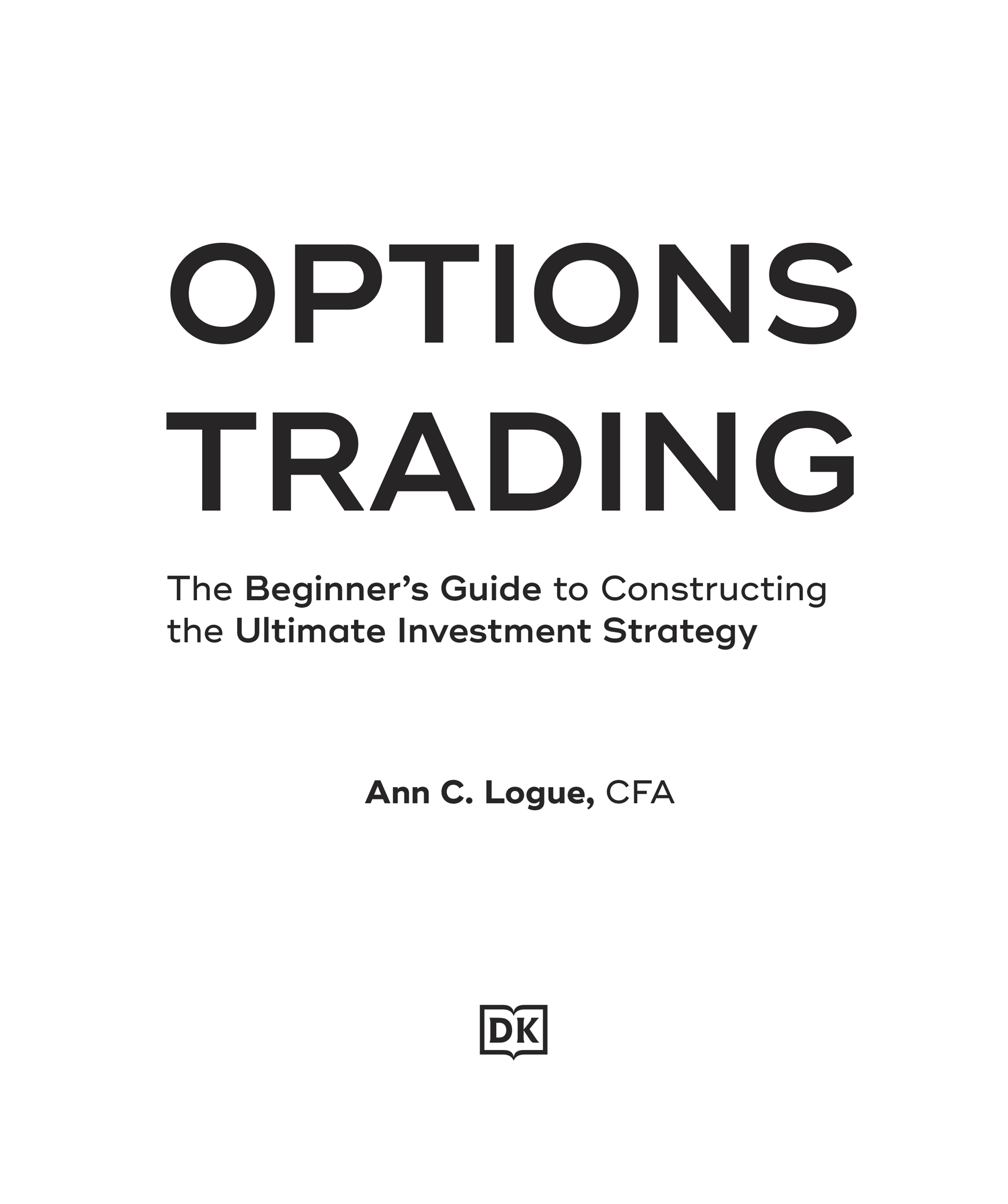CONTENTS
g
How to use this eBook
Preferred application settings
For the best reading experience, the following application settings are recommended:
- Orientation: Portrait
- Color theme: White background
- Scrolling view: [OFF]
- Text alignment: Auto-justification [OFF](if the eBook reader has this feature)
- Auto-hyphenation: [OFF](if the eBook reader has this feature)
- Font style: Publisher default setting [ON] (if the eBook reader has this feature)
- In Settings, change the font size to a size you are most comfortable with.
- Double-tap image to see the details clearly.
CONTENTS
g
As always, to Rik and Drew.
g
INTRODUCTION
Options are powerful tools for managing financial assets. They can be used to manage risk, generate income, and make money. Theyre also complicated. Lets get that up front. As a result, too many investors shy away from options because they confuse complication with risk . Others are led astray by advisers who take advantage of the complication to recommend high-commission, low-return strategies. Its unfortunate, but it happens.
Because options are complicated, though, they are an ideal topic for a book like this. In these pages, I break down the terminology and function of options to help you understand how you can use them to manage risk and to make money.
An option is a contract that gives you the right to buy or sell something at a predetermined price on a predetermined future date. You are not obligated to exercise the contract, so you wont unless it is to your advantage to do so. Most options are not exercised.
It sounds like a goofy thing, doesnt it? It sounds like something thats not quite real, not quite practical, and possibly sketchy, doesnt it? Perhaps it sounds like something thats used by financial people just to confuse the rest of us. However, options have real value.
Suppose you think about an option in another way: as insurance. Your car insurance policy gives you the right, but not the obligation, to file an accident claim up to the amount of value of the car while the policy is in force. You dont have to file a claim, and it might not be worth your while to even file it if you do have a minor accident that will cost less to repair than to cover your deductible. And yet, that policy has real value to you even if it expires unused.
An option is a form of insurance. It is written on the value of an underlying asset, such as a share of stock, a market index, or a foreign currency. Some people buy options to insure against an unfavorable price change.
Suppose you buy a noncancellable airplane ticket. It costs less than the fully cancellable ticket, and the difference in price is insurancean optionallowing you to get your money back if your plans change. The airline doesnt call it insurance or an option, but thats exactly what it is.
Some people sell options to bet that the price change wont be favorable. They are not bad people. Instead, they are providing the insurance. In a same way, your car insurance company is betting that you wont get into an accident so that it can keep the premiums you pay each month. The more likely you are to get into an accident, the higher car insurance costs. Parents of newly licensed teenage drivers know this well! And the more likely an option is to be exercised, the higher its cost will be.
Traders who buy options for their insurance value are known as hedgers. Those who provide the insurance are known as speculators who are looking to profit from price changes in the options. Speculators arent bad folks because they want to profit. The presence of speculators ensures that theres a healthy market for options. That, in turn, ensures that prices are fair. All this trading gives everyoneinside and outside the marketimportant information about the value of underlying assets, the amount of volatility in the market, and the outlook for prices over different time periods.
Your interest in options might be to hedge, to speculate, or to understand the price-discovery function. This book gives you information and ideas so you can use the options market to fit your needs.
How This Book Is Organized
Ive divided the book into a few parts:
covers basic terminology and operations of options. This segment of the financial market has its own language, borrowed heavily from calculus and Greek. Its not difficult, just different; the material here gives you a great basis to begin a trading plan that suits your needs.
reviews the factors that affect the price of an option and introduces the basic uses of puts and calls for both the hedger and the speculator. Armed with this knowledge, youll know how to use puts and calls to benefit your portfolio.
goes into detail on some of the ways that options can be used to hedge certain types of positions, make complicated speculative bets, and mimic the performance of other financial assets. You might never use this material, or you might find it unbelievably useful as you design your trading plan.
discusses research, taxes, and trade planning from the perspective of an options trader. Whether you use options a little or a lot, this information can help you improve your overall approach to the financial markets so you are better able to reach your goals, whatever they may be.
At the back of the book Ive shared a glossary of common terms and an appendix of resources for further study.
Acknowledgments
There are so many people I need to thank for their help. Linda Brink, Rik Lantz, and Baptiste Lecomte assisted in pulling the manuscript together. Russell Rhoads and Jaclyn Schuler of the Chicago Board Options Exchange brought me up-to-date on some of the changes in the industry. Brianna Vallesky and Joel Elconin of the Benzinga Premarket Prep show put out a call for questions about options to their listeners. George Avidon of The TradeXchange, Mark Longo of The Options Insider, Erika Olson, Brian Overby at TradeKing, and Richard Sandor gave me great insight about the day-to-day life of an options trader. The staff at the library of the University of Illinois at Chicago helped me track down some historic trading manuals. Marilyn Allen brought me together with Brook Farling to make it all possible. Thank you, everyone!
Please note that any opinions in this book are mine alone and do not reflect the positions of any employers or clients.
Special Thanks to the Technical Reviewer
This book was reviewed by an expert who double-checked the accuracy of whats presented here to help us ensure learning about options trading is as easy as it gets. Special thanks are extended to Gregory Clay. Gregory is a registered investment adviser, successful trader, and financial writer who shares profitable advice with those who consider themselves novice investors. He loves short-term, low-risk, high-profit trades, in particular options trading. He has a wide range of experience in the investment industry, including an extensive track record of using fundamental and technical investment analysis to increase the probability of profitable trades and minimize risks. Hes a regular contributor to several high-level investment services and utilizes a practical application of investment analysis to provide actionable information to active investors.

